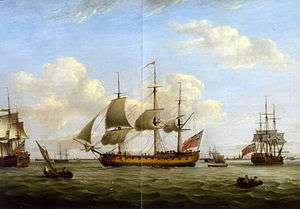HMS Achilles (1757)
 HMS Maria Anna, Earl of Chatham and Achilles (far right) off a coastal town | |
| History | |
|---|---|
| Name: | HMS Achilles |
| Ordered: | 14 November 1755 |
| Builder: | Barnard & Turner, Harwich |
| Laid down: | December 1755 |
| Launched: | 6 February 1757 |
| Completed: | By 17 May 1757 |
| Fate: | Sold on 1 June 1784 |
| General characteristics | |
| Class and type: | 1750 amendments 60-gun fourth rate ship of the line |
| Tons burthen: | 1,234 21/94 bm |
| Length: |
|
| Beam: | 42 ft 8 in (13.0 m) |
| Depth of hold: | 18 ft 9 in (5.7 m) |
| Propulsion: | Sails |
| Sail plan: | Full rigged ship |
| Complement: | 420 |
| Armament: |
|
HMS Achilles was a 60-gun fourth rate ship of the line of the Royal Navy, built by Barnard and Turner at Harwich to the draught specified by the 1745 Establishment as amended in 1750, and launched in 1757. She was ordered in November 1755. HMS Achilles was a Dunkirk-class fourth rate, along with HMS Dunkirk and HMS America.[1]
Career
HMS Achilles was launched on 6 February 1757 at Harwich.[2] At the Action of 29 April 1758, she was detached along with HMS Dorsetshire in pursuit of the 64-gun French ship Raisonnable. The Dorsetshire engaged the Raisonnable first, followed by the Achilles. After sustaining 35 casualties, Raisonnable was taken and later purchased for the navy as HMS Raisonnable.[3]
On 4 April 1759 Achilles engaged and captured the 60-gun French coastguard vessel St Florentine in a two-hour battle. The Achilles sustained 25 casualties - 2 killed and 23 wounded. St Florentine was later brought into the Royal Navy as HMS St. Florentine.
Later that year, the Achilles was the flagship of Rear-Admiral George Rodney when he sailed to L'Havre on 3 July. The fleet of four 50-gun ships along with 5 frigates, a sloop and 6 bomb ketches destroyed landing barges assembled in the harbour for a possible invasion of England. The Achilles remained at L'Havre for the rest of the year.
On 28 March 1762 the Achilles, along with several other warships and transports carrying 10,000 troops, set sail from Saint Helens to attack the French at Belleisle. The fleet arrived on 7 April. The next day the army attempted a landing under the cover of the Achilles's guns. The attack was forced back and the army lost 500 soldiers killed, wounded or captured. The army finally landed successfully on 22 April, and besieged the French in Le Palais until 7 June - when the French surrendered.
Achilles became the guardship at Portsmouth in 1763. Achilles was hulked in 1782 and sold on 1 June 1784.
References
- ↑ "HMS Achilles 1757 - Part 1 (German)".
- ↑ Phillips, Michael. "Michael Phillips' Ships of the Old Navy". Retrieved 28 August 2010.
- ↑ "No. 9790". The London Gazette. 9 May 1758. p. 1.